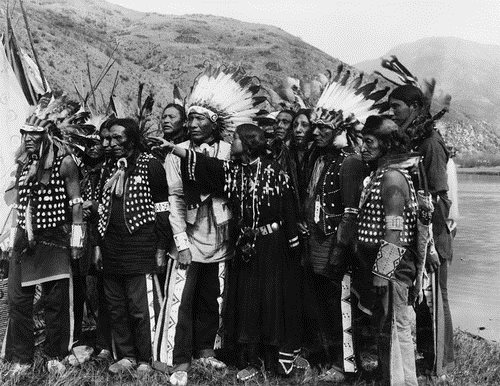
INDIAN REORGANIZATION ACT TEXT
What is the Indian Reorganization Act of 1934?
The Indian Reorganization Act of 1934 is also known as the Wheeler-Howard Act or the Indian New Deal. Among the more important provisions were returns to tribal government, self-management of assets and other provisions to deal with the long-term welfare of remaining Indian tribes such as vocational education. This Act essentially overturned the Dawes Act that for five decades had parceled Indian Territory out to individuals in hopes of speeding the assimilation of Indians through private ownership of land and breaking up the reservation system.
What were the provisions of the Indian Reorganization Act?
Section 2 – extends the placing of “trusts” on Indian lands
Section 3 – authorizes the Secretary of the Interior to restore tribal ownership of lands on Indian reservations. Also affirms the right for mining to occur on the lands of the Papago tribe in Arizona, so long as the tribe is compensated.
Section 4 – prevents the sale, gift, exchange or transfer of Indian Territory. This is to allow for the consolidation of Indian lands and prevents a “checker boarding” effect were non-Indians own land encircled by tribal territory.
Section 5 – the Secretary of the Interior is authorized to acquire land through purchase, gift, exchange etc. for the purposes of providing lands for the Indians. This land is held in trust, if necessary and exempt from state and local taxes.
Section 6 – authorizes the Secretary of the Interior to set forestry and livestock regulations to protect lands designated for Indians. The lands must not deteriorate under the watch of the Department of the Interior.
Section 7 – new Indian reservations may be created on acquired land and land may also be added to existing reservations
Section 8 – ensures that this Act does not apply to lands outside current Indian reservations
Section 9 – allocates up to $250,000/year to “defray the expenses” of organizations or corporations chartered by Indians under the auspices of this act.
Section 10 – allocates $10 million to be used to make loans to Indian chartered corporations for economic development of tribes. This is revolving credit repaid into a fund for all tribes. The transactions in this fund are reported to Congress.
Section 11 – $250,000 for loans to repay tuition for Indian students in vocational and trade schools.
Section 12 – Directs the Secretary of the Interior to appoint Indians to administrative positions that affect Indian tribes with subsequent vacancies giving preference to Indian candidates. The DOI sets and maintains standards for individuals to hold positions, regardless of civil service laws.
Section 13 – Details territories and possessions of the United States that are not covered by sections of this law.
Section 15 – establishes the right of Indians to bring suit against the United States and appropriations to Indian tribes cannot be used to offset claims brought by Indians against the government.
Section 16 – proclaims the rights of Indians to form tribal governments for the common welfare of the people living on the organization. The Secretary of the Interior sets the rules of election and approves the constitution and bylaws.
Section 17 – sets the provisions by which Indians living on a reservation may incorporate into a tribe. 1/3 of adults must petition the Secretary of the Interior to issue a charter of incorporation. With this charter, the tribe may purchase and sell land including parts of the reservation. This Section also protects the charter from revocation, unless by Act of Congress.
Section 18 – allows Indians living on reservations to vote against this act and have the provisions not apply to them. The Secretary of the Interior, within one year of the approval of the Indian Reorganization Act, will call a secret ballot election to approve the Act for that tribe after giving thirty days prior notice.
Section 19 – Defines the term Indian as all persons of Indian descent, recognized as members of a tribe with 50% or more of Indian blood. Defines the term “tribe” as any Indian tribes, bands, pueblos and Indians residing on a reservation.
How did the Indian Reorganization Act of 1934 differ from the Dawes Act?
The goals of the Dawes Act included dismantling tribes as social units, promoting native farmers, encouraging individualism and opening up lands currently held by Indians to white settlers. The IRA reversed this policy by working to create an economic backbone for tribal areas with self-government and minimizing the effect of outside settlers. Among the prominent provisions of the Dawes Act was the conferring of US citizenship on Indians that “civilized” by accepting a US government land allotment and other terms imposed by the Dawes Act. This land however, was not always viable, could be sold and many Indians were left landless, leading to the revisions that would become the Indian Reorganization Act. The Dawes Act made no considerations for tribal and cultural traditions of Indians and instead simply provided a framework for the easy exploitation of natives.
What have been challenges to the Indian Reorganization Act?
As recently as 1995, the state of South Dakota sued over the constitutionality of the IRA, specifically Section 5, which allowed the DOI to take land into trust for Indian tribes. After a lengthy legal battle were a lower federal court found Section 5 illegal, the case made its way to the Supreme Court where it was remanded to a lower court. The DOI revised its trust regulations and allowed the Sioux tribe to reapply for trust. It was challenged again, but this time the lower federal court upheld section 5. The Supreme Court now refuses to hear more about the issue. Other parts of the IRA have been upheld in various cases targeting the constitutionality of various parts and provisions.
Another case involved the Narragansett Indian tribe in Massachusetts that put 31 acres of land into trust with the DOI. The state sued successfully to block the trust arguing that the tribe did not receive federal recognition until 1980, long after the Act had gone into effect.
The right of tribes to have the DOI take lands into trust is also challenged in New York State where the Upstate Citizens for Equality and others filed a complaint against the Oneida nation and the provisions of the IRA. This group also claims that the tribes are not indigenous to New York State and thus do not have a right to the land. Many parts of the complaint, including claims that the IRA was unconstitutional were dismissed due to legal precedent that enforced the constitutionality of the Indian Reorganization Act.
What is the lasting impact of the Indian Reorganization Act of 1934?
The Indian Reorganization Act allowed for tribal bases to remain and for Indians to live slightly closer to the way they traditionally intended to live. Some tribal governance was reestablished allowing for greater efforts at preserving and regaining lost and fading traditions. Provisions to create an economic base for tribes led to the growth of tribal casinos and other gambling establishments as these lands are also exempt from taxes, as per the provisions of this Act.











